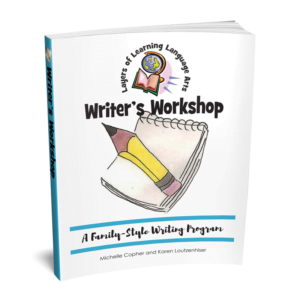Family-style homeschooling means everyone learning together, doing the same lesson at the same time. The magic of family-style homeschooling is that you build relationships and a love of learning while getting photosynthesis, dialogue rules, and the Battle of Mons under your belt.
During a lesson on the properties of water, I would gather my kids around the kitchen counter and have them all experiment with hard and soft water together. Everybody loves blowing bubbles whether you are 6 or 16.
Next, I would play a video about water for everyone to watch together. We would discuss, out loud, some of the amazing properties of water. Finally, I would assign them each to fill a sheet with illustrations and facts about water. The little ones would get writing help from an older sibling or a parent and the older ones would work independently. The little ones would do a little writing and the big ones would do more.
Which Subjects Can Be Taught Family-Style?
Family-style friendly
Family-style friendly subjects are those that are content based instead of skills based. Subjects where you’re learning facts, patterns, or information.
- History
- Geography
- Science
- Arts
- Writing
- Read-aloud & Literature
- Most elective type subjects
Not So Much
The subjects that don’t work well for family-style school are skills based where the individual student must incrementally gain abilities and knowledge in a way that must be methodical without skipping around or moving up and down between levels.
- Math
- Reading instruction (teaching little ones to read and improving reading skills in older kids)
- Spelling
- Handwriting/typing
A Family-Style Writing Lesson Example
We were using Writer’s Workshop Jump Start, a writing unit that teaches kids to love writing and how to work through the process of writing.
We began with a 5-minute Mini-lesson from the sidebar. The Mini-lessons are grammar or usage lessons and like the rest of family-school, they can be done as a group. I decided to do “sentence imitation” this time and write a sentence up on the chalkboard where everyone could see.

The kid’s job was to write a sentence with the same structure, but their own words. To ramp up the fun, we made them funny and then voted for the funniest at the end.

Then we moved to the main lesson of the day, “Ten Word Challenge”. Together we brainstormed 10 unusual words and I wrote them up on the chalkboard.

Then each child was challenged to write a passage including all 10 words. The younger, less experienced writers wrote less than the older, more experienced writers. Each person got to practice writing and each person grew incrementally as a writer.
This part of the writing lesson is private, but I always ask the kids if they want to share their writing. They usually do. We all listen. We all cheer and compliment the writer. Writing this way, as a family, gives each writer lots of positive support and practice sharing their thoughts in a happy criticism-free environment, so they will continue to be brave enough to keep sharing the deepest parts of themselves.
The entire Writer’s Workshop program is family-style magic.
The Ingredients for Family-Style Homeschooling
There are many ways to approach a family-style lesson, but I’ll lay out a fool-proof recipe for a fun family experience that works so everyone is learning even when you’ve got mixed ages.
- Start with an attention grabber. I like to head straight into a hands-on craft or experiment. Nothing grabs kids like an exploding test tube or a chance to paint rocks.
- Next, teach the facts and information with a book or video. This is a group thing, so do a read-aloud or watch together.
- Finish with a piece of writing that each child completes independently. This is where you get to tailor your learning to each child. They all have the same assignment, but the younger ones write less than the older ones. Little ones do a sentence while older ones complete a paragraph or three.
The Magical Bit
To me, the magic of family-style homeschooling isn’t that it saves me time and simplifies my day, though it does do those things. The magical bit is that while we learn about the pyramids of Egypt and cells, we’re also sharing experiences as a family, growing closer, having fun, and supporting each other in positive ways.
We have so much to talk about. We take pictures of our projects and experiments, because it’s not just school, it’s exploring and building and getting messy. Most importantly, we do it together. And we make memories way more important than memorizing the countries of Europe.
You Need A Family-Style Curriculum
Family-style homeschooling works when your curriculum is designed for everyone to learn together. It takes a fat load of work to pull together activities, books, videos, and writing assignments that work for all ages. Since one of the benefits of family-style homeschooling is the lighter teaching load, doing it yourself seems despairingly self-defeating.
Give family-style homeschooling a shot with some sample lessons, or even better, a free unit from Layers of Learning. Once you get the hang of it, we predict you’ll never turn back.
Get a Free Unit
Choose between the first unit in each Layers of Learning subject to try for free when you sign up for the newsletter.
We never spam and you can cancel your subscription at any time.






